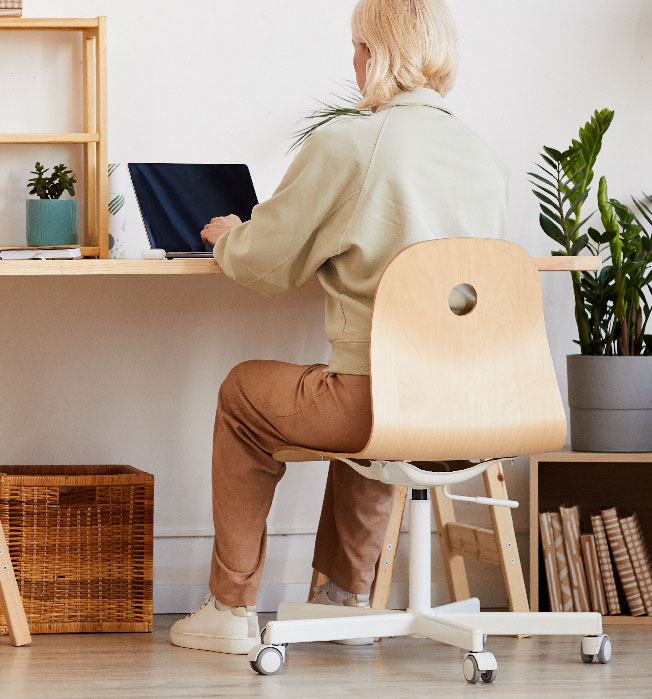Even before the COVID-19 epidemic, the majority of people worked from home, either partially or entirely. As states require non-essential employees to stay at home, that number has risen dramatically. If you’re one of these people, you might be experiencing new aches and pains that weren’t present at work.
So, if you work from home, you’re probably sitting in a lounge chair or on your bed, either using your computer on a standard table or a kitchen countertop, or in a lounge chair or on your bed. You’re probably not in good shape wherever you’ve set up camp for the day. You may not need to be concerned if you do this for short periods of time, but our weeks at home are quickly growing into months. Even after the pandemic has gone, remote working is likely to remain the norm for millions of workers as businesses realise that some tasks no longer require in-office hours.
So, what are your options? Spend as much time as possible working in a neutral posture–a comfortable body position with no painfully bent or twisted body parts–and walk around occasionally to enhance circulation. This entails paying attention to the following ten computer-related tips:
1. Keep your neck straight while looking at your computer screen.

Place your screen at a comfortable viewing height in front of you. Don’t glance down at your screen, such as a laptop or phone on a table. And don’t swivel your screen so that you have to twist your neck–some people like to set their keyboard and mouse in front of them with their screen off to the side, but this causes neck strain. If you have a separate screen or are using a laptop, you may need to lift it to a comfortable viewing position right in front of you by stacking books or placing it on a cardboard box.
2. Create a separate work area

Working remotely allows you to work while sitting, standing, or even lying down. This home rule, though, can be quite costly to your back. Working from your bed is not a good idea just because you can.
It is recommended that you designate a separate workstation during office hours. It might be your living room, study, or even your balcony. It’s a good idea to get out of bed and work while keeping a decent posture.
3. Place your screen in front of a bright window

Don’t work with your back to a window, as the light coming in will generate a glare on your screen, and don’t work facing a window, as you’ll be staring into the light, to reduce the risks of visual eye strain from glare or partial retinal adaptation. Your screen should be perpendicular to the window unless the window has shades or drapes that may be closed. If you’re working at a glass table, cover it to avoid glare from reflections.
4. Place your keyboard, mouse, or touchpad in front of you at a comfortable height.

Use a separate keyboard and mouse if your laptop has been lifted to get your screen to the proper level. Make sure your forearms and hands are level and straight when using the keyboard and mouse, and that your arm is near to the side of your body when using a mouse. The hand’s nerves emerge from the neck and travel down the shoulder, elbow, and wrist. The nerves in your arm aren’t constricted when it’s at your side, but the further you stretch it out to the side, the more likely you are to strain your neck or shoulder.
5. In the morning, stretch your back.

Stretching is one of the strategies to relieve back discomfort while working from home. Start your day with some simple stretching exercises, with a special focus on your back. Stretching your back first thing in the morning will help you start your day in good shape.
6. Find the perfect chair

Don’t try to sit up straight or slouch forward like a turtle on your chair. Your lower back is curved inwards towards your stomach. This is known as lordosis, and it is the most relaxed posture for the lower back, putting the least amount of pressure on the intervertebral discs. The lumbar spine bends outward when you lean forward, causing kyphosis, which puts a lot of pressure on the intervertebral lumbar discs. So you want to sit so that your lumbar spine’s natural lordotic curve is accommodated.
Ensure that you can sit back in your chair so that the chair back can support some of your body weight, and that you are seated near enough to comfortably reach your keyboard and mouse. Use a cushion or rolled-up towel behind your lower back if the chair does not provide adequate lower-back support. It’s a less effective and cheaper alternative to an ergonomic chair, but it’s better than nothing.
7. Limit the amount of time you spend in bed.

A bed is even worse for you than a chair because unless you sit on the bed’s side, your legs will be crossed or extended horizontally, providing support for your laptop. You’ll have to lean down because that’s too low for proper screen viewing. If you have no other choice but to sleep in a bed, lean against the headboard with a pillow behind your back and your laptop on a cushion in your lap. Alternatively, acquire a low table that fits over your legs and allows you to type at a comfortable height without hurting your neck.
8. Make sure to move every hour

One of the disadvantages of working from home is the restriction on physical movement. To perform your day’s activities, you only needed a computer and access to the internet. Moving your body, on the other hand, is just as vital as maintaining proper posture.
If you sit for long periods of time, your body will become stiff. It is recommended that you move in brief bursts throughout the day. You can set an hourly alarm to remind you to take a stroll around the home.
9. Correct posture exercises

While working from home, there are a few exercises that may be done to prevent back strain. These workouts are suitable for use indoors and do not necessitate a large workout area.
Shoulder blade squeezes– This exercise is as easy as it sounds. Sit up straight and press your shoulder blades inwards at the back of your neck. Before relaxing, hold this position for 5-6 seconds. This exercise can be done twice a day and performed 10-15 times for a strong and healthy back.
Side bends- To do side bends, you’ll need to stand up. It’s a basic workout that supports the back while stretching the sides of the stomach. You must stand with your feet shoulder-width apart and your back straight. Bend to your right side and hold that position for 5-6 seconds. Return to your starting position and bend to the left. On each side, repeat 10-15 times.
Knee to chest stretches, side planks, leg lifts, and other exercises can also help you maintain good technique.
10. Do not let your feet dangle in the air

Keeping your feet on the floor is one of the best ways to avoid back pain while working from home. It’s best not to dangle your feet in the air.
It’s also a good idea to keep your feet below the screen’s height. With such positions, the risk of back pain increases. Your feet should be flat on the floor or on a footstool.
You can also look on ‘Five Stretches Exercise you should do Every Day’
